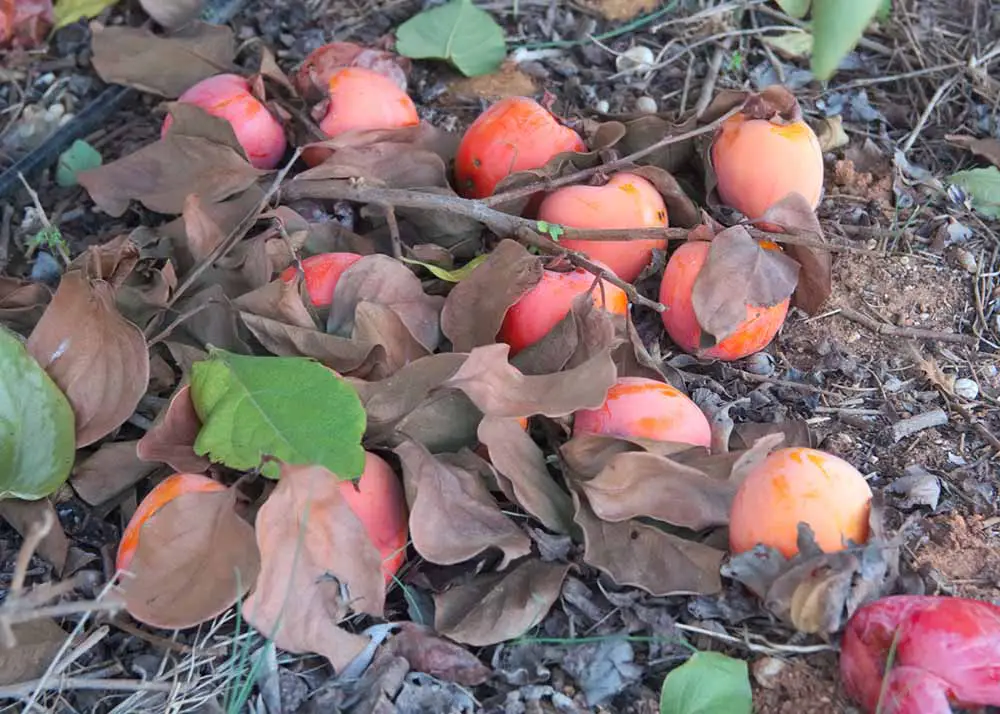
We may receive commissions from purchases made through links in this post, at no additional cost to you.
Fruit trees have a sneaky way of making you feel comfortable, giving you a good crop one season, then suddenly dropping all of their fruit the next. This is exactly what happened with my persimmon tree.
Remembering the amazing-tasting persimmons I had the previous year, I eagerly awaited the next year’s crop. The tree flowered, and small fruits started to grow. I went out of town for a short time, and when I came back – no persimmons! What happened? And how can I prevent my persimmons from dropping next time?
Persimmon trees drop their fruit due to stress from weather, inadequate sunlight, pests and diseases, over- or under-fertilization, drought, or overwatering. Other reasons include a lack of pollination, tree age, or the variety itself. Adjusting watering, feeding, and other cultural habits can help prevent fruit drop.
It’s certainly worth doing everything possible to keep persimmons on the tree rather than on the ground. Luckily, the solutions to the fruit dropping problem are pretty straightforward. Read on to learn the reasons a persimmon tree might drop its fruit prematurely and, more importantly, what you can do to hopefully prevent it from happening again.
Why do persimmon trees drop their fruit early?
Persimmon fruit drop is essentially a response to stress. Just like with people, fruit trees can become stressed by things in their environment: extremely hot or cold temperatures, strong winds, drought, overwatering, nutrient deficiencies, pest infestation, disease, or lack of pollination, for example.
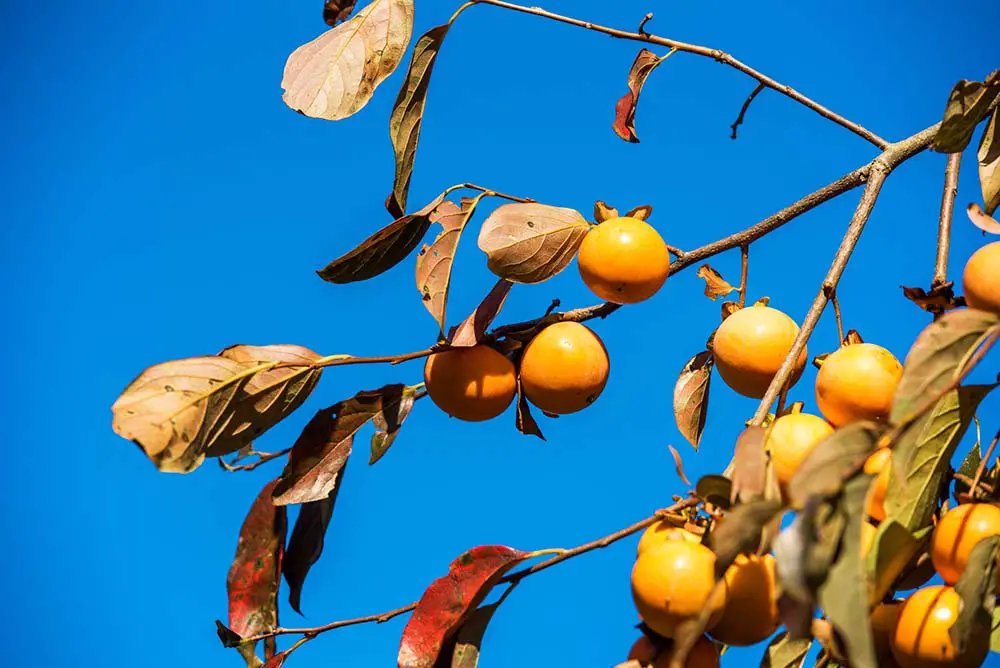
Certain trees are more prone to dropping persimmons than others. Asian persimmon trees (Diospyros kaki), particularly those that are self-pollinating like ‘Fuyu’, tend to drop some fruits in midsummer. Pollination may not be necessary for fruiting, but it will help keep more persimmons on the tree.
There are several natural – and even good – reasons a persimmon tree might let some of its fruit fall. Like many fruit trees, a persimmon tree often starts the season with more fruit than it can actually support all the way to ripeness. You’ll often find that some of the fruit falls early in the season, which allows the remaining persimmons to grow to their full size and flavor.
This natural fruit drop is called self-thinning, but fruit thinning can be done manually as well. If the tree is bearing a particularly heavy fruit load, remove some of the young fruits on the tree. Aim to space the persimmons relatively evenly along the branch, about 6 inches apart.
Both American (Diospyros virginiana) and Asian persimmon trees will drop some fruit throughout the summer. Whether the young fruit is removed by hand or allowed to drop naturally, the tree can then put its resources to developing fewer fruits. This results in bigger, tastier persimmons.
Learn more: American vs. Asian Persimmons: What’s the Difference?
How to Prevent Persimmon Fruit Drop
If environmental stress is the cause, then the solution is found in improving the tree’s environment. In other words, take steps to protect the persimmon tree from adverse weather, optimize cultural practices such as watering and fertilizing, and provide the best growing situation possible.
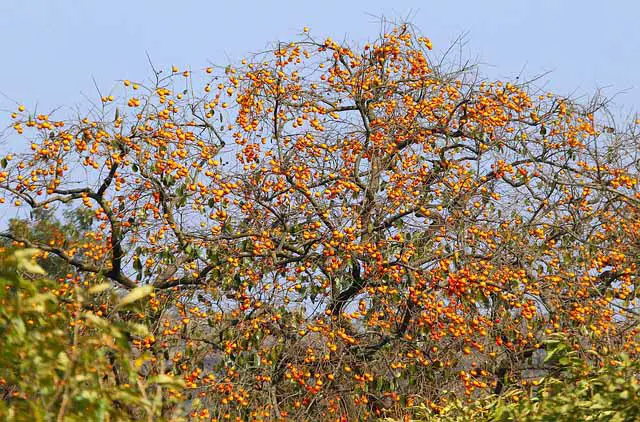
Let the Tree Mature
It is very common for young trees to drop most (or all) of their fruit the first few seasons. Newly planted persimmon trees put the majority of their energy to developing a root system and establishing a good canopy. There aren’t many nutrients to spare for fruit development. It’s basically a situation of “let the best persimmon win.”
Older trees have more extensive root systems, and they have the ability (and size) to store and access nutrients. This capability allows an older tree to withstand a higher amount of stress without resorting to drastic self-preservations methods, like dropping fruit.
Young trees can’t yet store large amounts of nutrients to access when needed, and what little they have needs to be used on the roots and overall growth. Therefore a young tree under stress will sacrifice it’s fruit so it can survive.
Asian persimmons begin fruiting around their 5th year. American persimmons take longer (7 to 10 years) before producing their first harvest. If your tree is on the young side, fruit drop may just mean it’s not yet ready to support a persimmon crop. Just wait a couple more years. As the tree matures, soon you’ll have more persimmons than you know what to do with!
Related: How Big Does a Persimmon Tree Grow?
Protect from Extreme Weather
Persimmon trees are fairly tolerant to heat and cold (especially American persimmons), but sudden changes or extremes could cause the tree to have a stress response (you guessed it – fruit drop). Weather stress is one of the most common reasons a persimmon tree may drop its fruit early.
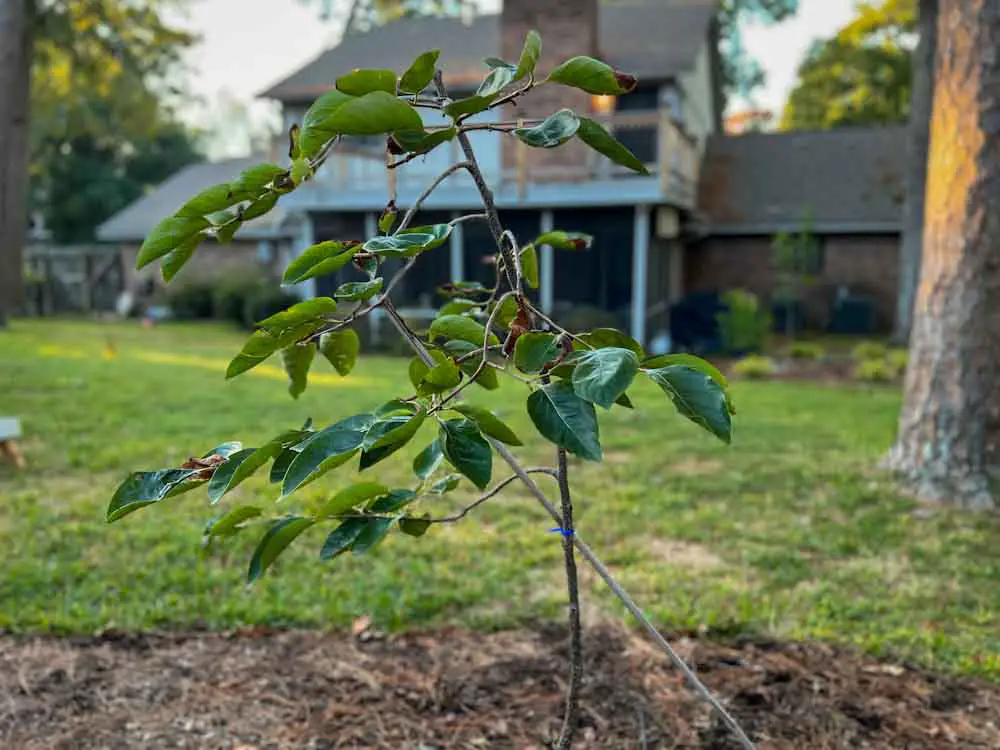
Heat
Be on the lookout for unseasonable heat waves in spring, especially when fruits are small. A sudden rise in temperature causes more moisture to evaporate from the persimmon tree’s leaves. As a result, the tree has to drop the young fruits in order to conserve moisture.
What to Do: The solution is simply to water more frequently during hot weather to replace the moisture loss. As long as its roots have access to water, the tree can uptake as much moisture as it needs to support fruit growth, even in the heat.
If you live in a hot climate, plan to water deeply a couple of times a week (at least) during the worst heat of summer. If possible, take advantage of some afternoon shade. The sun is more intense in hot climates (closer to the equator in both hemispheres), which can lead to sunburn and extreme heat stress. A little shade goes a long way to prevent this.
Heat stress was the main issue with my ‘Fuyu’ persimmon tree, pictured above. We experienced an extreme period of high heat and drought in the late summer, and my sandy soil couldn’t hold onto enough moisture. My tree survived the heat wave (and my being out of town), but only because it dropped all of its fruit.
Cold
Persimmon trees ripen in late fall, and they can handle some cold. Even Asian persimmons, which are really subtropical fruits, are fairly cold tolerant (down to about 10°F). American persimmons ripen all through the fall and winter, so cold temperatures don’t bother them much (they can survive down to -30°F).
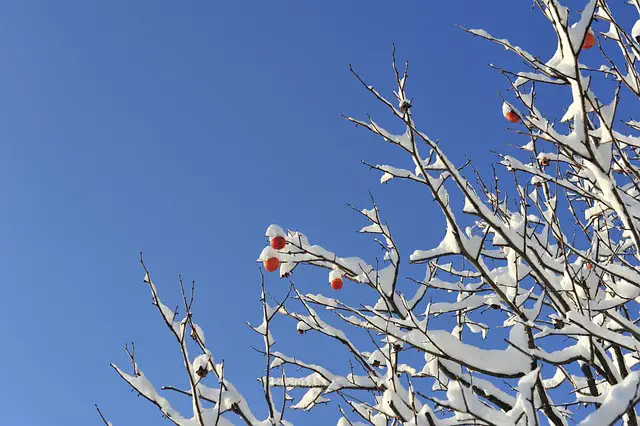
The problem comes in the spring. Persimmon trees are deciduous, so they go dormant in the winter. Once they wake up in spring and begin to grow again, the tender new growth and blossoms are very susceptible to cold damage.

Curious about any garden-related terms? Click on a highlighted word in the text, or visit The Fruit Grove Glossary to find out more.
Late spring frosts will often cause persimmon fruit drop. A frost at the end of spring, when blooms first open and young fruits start to form, could damage the developing fruits. You may not even notice the damage until the fruits fall weeks or months later.
Cold can also damage the tender stems that hold the persimmons. If a stem is damaged, then nutrients can’t reach the fruit. The persimmon may become deformed or simply malnourished, so it falls.
What to Do: One of the simplest ways to combat cold damage (and the resulting fruit drop) is to mulch around the persimmon tree. Spread a thick layer of organic mulch (leaves, wood chips, pine needles, straw, etc.) around the base of the tree and out to the dripline. Leave several inches of space around the trunk for airflow.
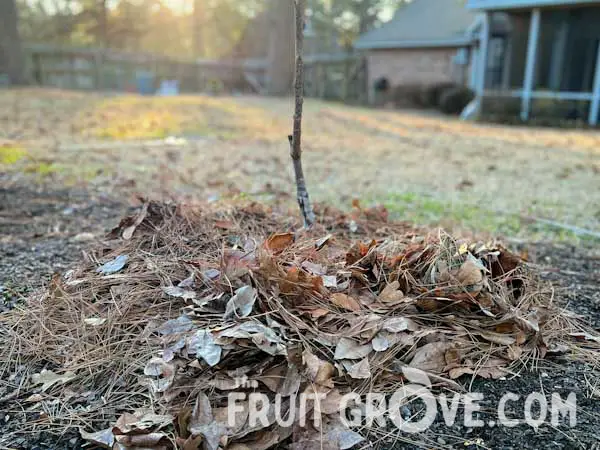
Mulch helps insulate the ground and keeps it from warming up too quickly in spring. The warming ground in spring signals the tree that it’s time to wake up and start growing again. Keeping the ground cooler in spring could delay blooming a little, perhaps protecting the blossoms from a late frost.
For more ways to protect persimmon trees from cold, as well as a list of cold-tolerant persimmon varieties, check out: Persimmon Trees are for Cold Climates Too (15 Trees to Try).
Provide Adequate Sunlight
Persimmon trees, like most other fruit trees, need 6 to 8 hours of direct sunlight per day to support fruit development. Inadequate sunlight may prevent the tree from fruiting, or could cause more than the usual number of fruits to drop.
Light has a direct impact on fruit quality, too. Light is an essential part of photosynthesis, the process of a plant turning sunlight into carbohydrates. Those carbohydrates, or sugars, are what the tree uses to support various processes, including developing fruit. Persimmons (and surrounding leaves) that get adequate light develop more sugars and better overall flavor.
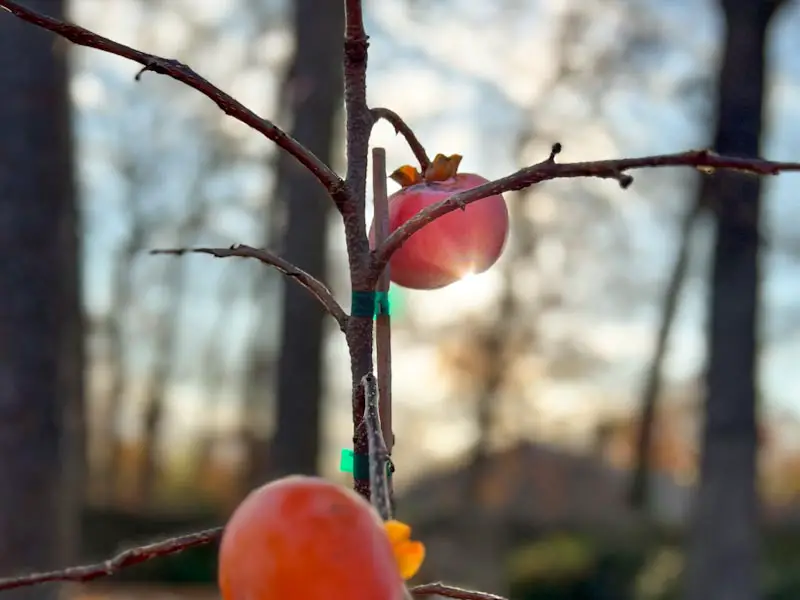
What to Do: If you haven’t planted your persimmon tree yet, simply choose a spot that has adequate sun exposure. The sun is more intense in southern climates (or northern, in the southern hemisphere), so consider picking a location with a little bit of late afternoon shade.
Learn more: Planting a Persimmon Tree: Where, When, and How to Do It
If it’s too late to move your tree, there are still a few options. For one, prune the tree so more light can penetrate the canopy and reach the ripening fruit. Also, keep nearby trees trimmed so they aren’t blocking any light.
Find out exactly how to prune an Asian persimmon tree here: Pruning an Asian Persimmon Tree in 5 Simple Steps
Persimmon trees can also be grown in containers. A big advantage to potted fruit trees is being able to move them as the light changes throughout the growing season. If your full-sun space is limited, consider container planting.
Increase Pollination
Pollination is a complex topic when it comes to persimmon trees. American persimmon trees need to be pollinated in order to produce fruit, but Asian persimmon trees might or might not be self-fertile (depending on the variety)
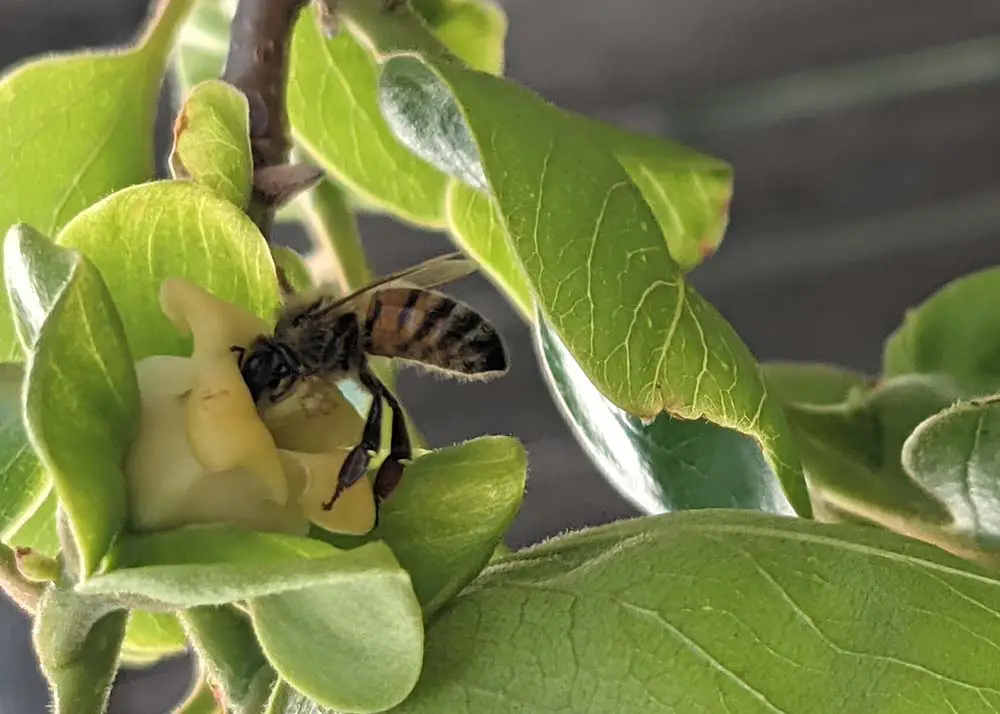
Luckily, I wrote a whole article all about pollination for persimmon trees! Check it out here: Persimmon Tree Pollination: Do You Need Two Trees?
If a persimmon tree needs to be pollinated in order to form fruit, then a lack of pollination will simply result in a lack of fruit – rather than already formed fruits dropping off the tree. That’s a different problem for a different article (like the one above!).
Self-fertile persimmon trees (such as ‘Fuyu’, ‘Ichi-Ki-Kei-Jiro’, ‘Tamopan’, and ‘Hachiya’) are parthenocarpic, which means they will form fruit without being pollinated. However, a second tree of a different variety nearby will greatly increase the size of the fruit harvest.
Unfertilized fruits are more prone to dropping off the tree early, especially if other stressors are present. ‘Fuyu’, although one of the most popular varieties, is also notorious for having this problem. This is another reason for my dropped fruit – my unpollinated ‘Fuyu’ wasn’t able to withstand the heat and drought.
Learn more tips for growing ‘Fuyu’ persimmons here: How to Grow Fuyu Persimmons: From Planting to Eating
What to Do: If you have the space, plant another Asian persimmon tree nearby. ‘Fuyu’, ‘Gailey’, and ‘Gosho’ are good pollinizers for other Asian persimmon varieties.
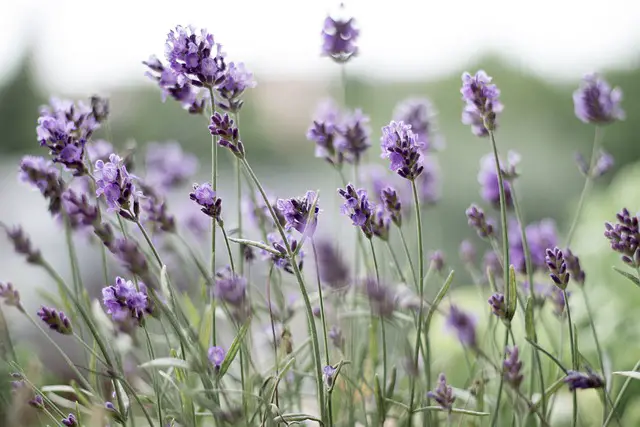
Encourage pollinators (such as bees) to come around by planting pollinator-friendly flowers in the surrounding area. Herbs such as chives, lavender, and mint also make good companion plants.
Fertilize Just Enough (But Not Too Much)
Over-fertilizing, especially with a high nitrogen fertilizer, will cause a persimmon tree to grow excessive leafy growth but not fruit. If young persimmons have already started growing, too much fertilizer could lead to fruit drop.
On the other hand, if the tree can’t get enough nutrients it may not have what it needs to support fruit growth. If you have very sandy, lean soil, you will probably need to fertilize a little more often.
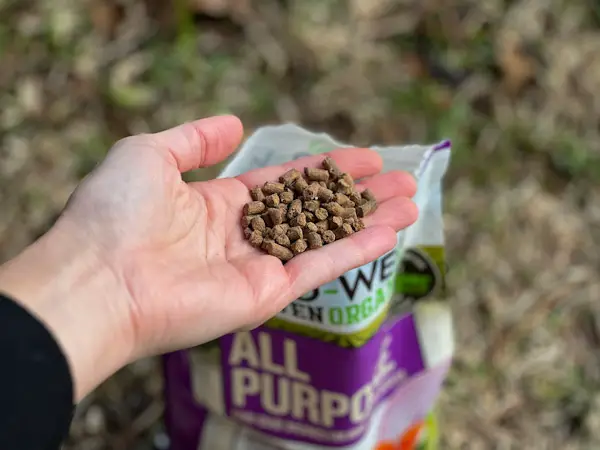
What to Do: You may not need to fertilize your persimmon tree at all. If the leaves are dark green, and if the tree is growing about 12-24 inches per year, then there’s no need to fertilize.
If the tree is growing significantly slower, or if the leaves look uniformly pale, it may need some additional nutrients. Sprinkle on a balanced NPK fruit tree fertilizer (such as this one) when you see new growth in spring. If you have very sandy soil, you may need to fertilize once or twice more throughout the growing season. Stop fertilizing after August so the tree can wind down for the year in preparation for dormancy.
Prevent Drought Stress
Extended periods of drought, especially combined with high heat, can cause a persimmon tree to drop its fruit as a stress response (as I learned the hard way). The first thing a drought-stressed persimmon tree will do is let the fruits fall in order to conserve energy and moisture. Its first priority is survival.
Newly planted persimmon trees are particularly prone to drought stress. It takes a lot of water to establish a healthy root system and canopy. Water frequently (about once every 7-10 days, more in hot weather) the first year after planting a persimmon tree.
What to Do: The easiest way to prevent fruit drop because of drought is to set up drip irrigation on a timer. Use 1-gallon-per-hour drip emitters, and add more emitters as the tree grows. (For example, a 1-year-old tree may only need 1 or 2 emitters, then add an emitter every year).
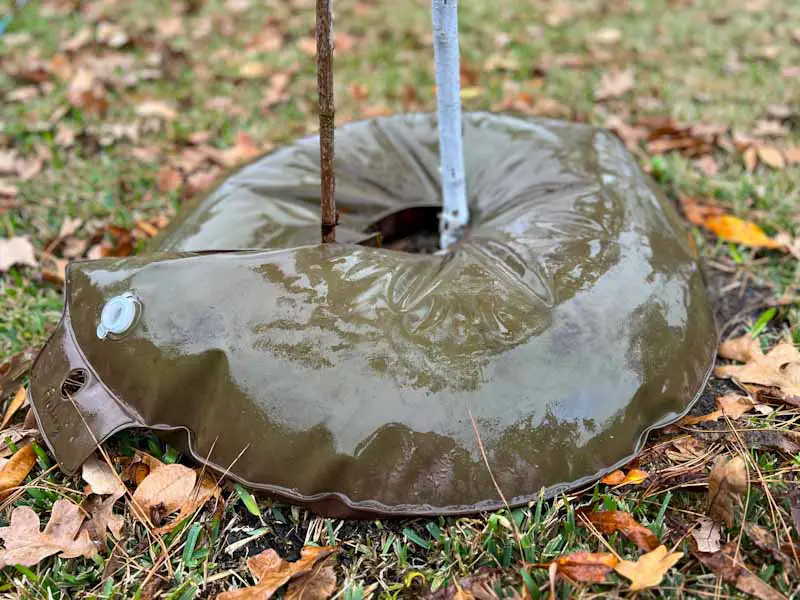
I also love to use these watering bags, especially with young fruit trees. These bags have saved my newly-planted trees many times through the hot summer months. Simply fill the bag up with water from the hose, and emitters in the bottom slowly release the water over about 8 hours. This allows the tree’s roots to absorb more moisture.
Avoid Overwatering or Poor Drainage
Persimmon trees hate sitting in saturated, soggy soil that’s slow to drain. Poor drainage will literally suffocate the roots, which will quickly lead to other issues (including tree death). And, as usual, a stressed persimmon tree will first drop its fruit.
Once the tree is established in the landscape, it may not need much additional watering (except in extended dry weather). Overwatering will probably cause more harm than good.
Poor drainage is potentially the bigger problem, as it causes major problems for the root system and overall tree health. Water and air must be able to flow freely through the soil in order for trees to absorb the nutrients necessary for growth and fruit development.
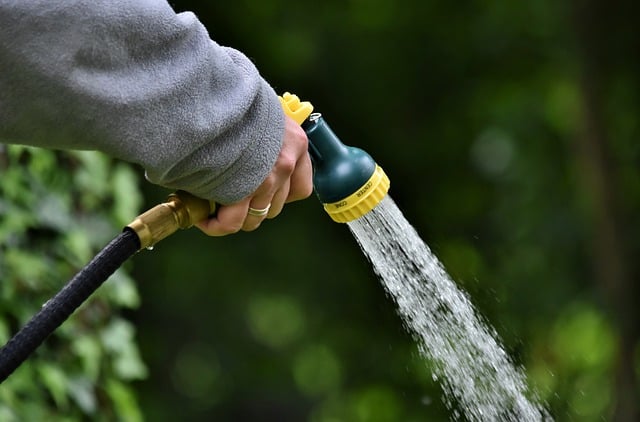
What to Do: As mentioned above, water a newly planted tree every 7-10 days. After the first year, only provide supplemental water during extended periods of dry weather, especially combined with high temperatures.
It’s difficult, if not impossible, to improve soil drainage around an already planted tree. If you haven’t planted the persimmon tree yet and are concerned about your soil, you can add amendments or plant the tree on a mound to help with drainage.
Learn all about the importance of soil drainage for fruit trees, how to fix drainage problems, and what you can do to help your established fruit trees here: Soil Drainage for Fruit Trees: Everything You Need to Know
Watch for Pests or Diseases
Persimmon trees are less prone to diseases and pests than many other fruit trees, but a severe infection or infestation could lead to fruit drop. Leaf spot (anthracnose), crown gall, or persimmon wilt can cause problems, although usually they aren’t serious enough to warrant treatment.
Pests such as mealybugs, aphids, scale, or persimmon trunk borer might bother the tree or its fruit. In most cases, neem oil or horticultural oil sprays are enough to keep these bugs in check.
What to Do: The safest bet is to contact your local extension service for specifics on what pests and diseases plague persimmons in your area, as well as how to treat them. Prevent fungal diseases and overwintering pests by keeping the area around the tree free from weeds, fallen leaves, and other debris.

